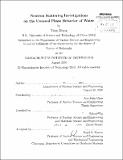| dc.contributor.advisor | Sow-Hsin Chen. | en_US |
| dc.contributor.author | Zhang, Yang | en_US |
| dc.contributor.other | Massachusetts Institute of Technology. Dept. of Nuclear Science and Engineering. | en_US |
| dc.date.accessioned | 2013-01-23T20:23:15Z | |
| dc.date.available | 2013-01-23T20:23:15Z | |
| dc.date.copyright | 2010 | en_US |
| dc.date.issued | 2010 | en_US |
| dc.identifier.uri | http://hdl.handle.net/1721.1/76568 | |
| dc.description | Thesis (Ph. D.)--Massachusetts Institute of Technology, Dept. of Nuclear Science and Engineering, 2010. | en_US |
| dc.description | Cataloged from PDF version of thesis. | en_US |
| dc.description | Includes bibliographical references (p. 91-104) and index. | en_US |
| dc.description.abstract | Water is the most ubiquitous substance on earth, and is essential to sustain all known forms of life. However, despite centuries of research, a coherent picture of the unusual phase behavior of water is so far lacking. The most promising theory under scrutiny relies on the hypothetical existence of a liquid-liquid phase transition and an associated liquid-liquid critical point hidden in the region of supercooled temperatures and elevated pressures, where bulk water does not exist in liquid state. Therefore it is a grand experimental challenge to investigate the properties of water, both thermodynamic and dynamic, in the relative region of the phase diagram. A combination of neutron triple-axis spectrometer and small-angle neutron scattering instrument are used to measure the density of water confined in a nanoporous silica matrix MCM-41-S in a Temperature-Pressure range inaccessible for the bulk (300-130 K and 1-2900 bar), namely, the equation of state p(T, P). The measured isobaric density profiles clearly show a change of behavior around 1500 bar. This experiment provides the most direct evidence supporting the existence of a liquid-liquid critical point in such confined water. The experimental result further implies that the nature of the liquid-liquid critical point of water might be of a tricritical type. Moreover, the reported density data of confined water under extreme conditions are valuable for the vast communities in biological, geological and planetary sciences. Parallel to the density measurement, the dynamics of water in confined geometry, such as aged cement paste and the vicinity of protein surfaces, are also investigated using a variety of quasi-elastic and inelastic neutron scattering spectrometers. A wide range of pre-glass-transition phenomena, such as dynamic crossover, dynamic heterogeneity and boson peak, are observed above the conventional glass-transition temperature. Possible explanations are discussed in the frameworks of the liquidliquid critical point scenario of water and the extended mode-coupling theory. Computer simulations are frequently exploited to achieve a unified interpretation. These new findings of confined water may provide new insights to the research on glassy systems of multi-scales as well as innumerable examples in soft condensed matters, where randomness and cooperativity are common and intrinsic. | en_US |
| dc.description.statementofresponsibility | by Yang Zhang. | en_US |
| dc.format.extent | 105 p. | en_US |
| dc.language.iso | eng | en_US |
| dc.publisher | Massachusetts Institute of Technology | en_US |
| dc.rights | M.I.T. theses are protected by
copyright. They may be viewed from this source for any purpose, but
reproduction or distribution in any format is prohibited without written
permission. See provided URL for inquiries about permission. | en_US |
| dc.rights.uri | http://dspace.mit.edu/handle/1721.1/7582 | en_US |
| dc.subject | Nuclear Science and Engineering. | en_US |
| dc.title | Neutron scattering investigations on the unusual phase behavior of water | en_US |
| dc.type | Thesis | en_US |
| dc.description.degree | Ph.D. | en_US |
| dc.contributor.department | Massachusetts Institute of Technology. Department of Nuclear Science and Engineering | |
| dc.identifier.oclc | 823510482 | en_US |
